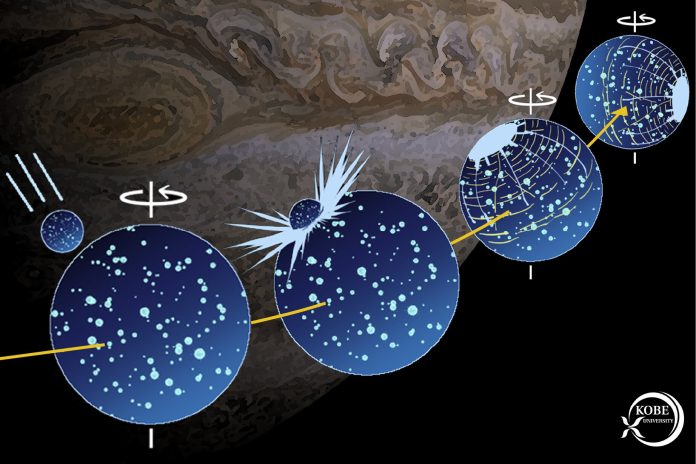
Around 4 billion years ago, a massive asteroid struck Ganymede, Jupiter’s largest moon, causing it to shift its axis, according to a new study by a researcher from Kobe University.
The asteroid responsible for this event was about 20 times larger than the one that caused the extinction of the dinosaurs on Earth, making it one of the most significant impacts in the solar system.
Ganymede is the largest moon in the solar system, even bigger than the planet Mercury. It’s particularly interesting because it has a liquid water ocean beneath its icy surface.
Similar to Earth’s moon, Ganymede is tidally locked, meaning it always shows the same side to Jupiter, leaving a far side hidden from view.
On many parts of Ganymede’s surface, furrows—large grooves forming concentric circles—can be seen. These patterns led scientists in the 1980s to believe that a massive asteroid impact had occurred long ago.
“The moons of Jupiter—Io, Europa, Ganymede, and Callisto—each have unique features, but what caught my eye were these furrows on Ganymede,” said Hirata Naoyuki, a planetologist from Kobe University.
“We knew they were created by an asteroid impact about 4 billion years ago, but the size of the impact and its effects were still unclear.”
Due to the difficulty of gathering data from such a distant object, research on Ganymede has been challenging. Hirata was the first to notice that the spot where the impact occurred is located almost directly on the farthest side from Jupiter.
He compared this to an event on Pluto that caused a similar axis shift and used that knowledge to suggest Ganymede had also undergone a reorientation. Hirata specializes in simulating asteroid impacts, and this allowed him to calculate the scale of the event that could have caused the moon’s axis to shift.
In a study published in Scientific Reports, Hirata concluded that the asteroid responsible had a diameter of about 300 kilometers, creating a massive crater between 1,400 and 1,600 kilometers wide.
This asteroid was about 20 times bigger than the one that hit Earth 65 million years ago. According to his simulations, only an impact this large could have caused the moon’s rotational axis to shift into its current position.
“The giant impact must have played a major role in Ganymede’s early evolution,” Hirata explained. “However, we still need to study how this impact affected Ganymede’s interior, especially its thermal and structural characteristics.”
Ganymede is the target of ESA’s JUICE space probe, which is expected to arrive at the moon in 2034. The mission will provide data that could answer many of Hirata’s questions and offer a deeper understanding of Ganymede’s history.



